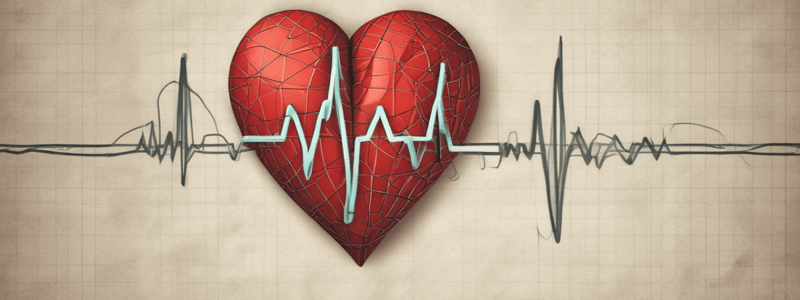Podcast
Questions and Answers
What is the measure of the x-axis in an ECG tracing?
What is the measure of the x-axis in an ECG tracing?
- Time (s) (correct)
- Voltage (mV)
- Heart rate (bpm)
- Axis deviation (degrees)
What is the normal range of heart rate in a normal sinus rhythm?
What is the normal range of heart rate in a normal sinus rhythm?
- 50-90 bpm
- 70-110 bpm
- 60-100 bpm (correct)
- 40-80 bpm
How is the heart rate determined in an ECG with an irregular rhythm?
How is the heart rate determined in an ECG with an irregular rhythm?
- Counting the number of QRS complexes in 1 minute
- Dividing 300 by the number of large squares between consecutive R waves
- Multiplying the number of P waves in 10 seconds by 6 (correct)
- Counting the number of P waves in 1 minute
What is the characteristic of a normal T wave?
What is the characteristic of a normal T wave?
What is the normal duration of the PR interval?
What is the normal duration of the PR interval?
What is the characteristic of a normal QRS complex?
What is the characteristic of a normal QRS complex?
What is the normal axis deviation of the heart?
What is the normal axis deviation of the heart?
What is the condition associated with an extreme axis deviation (EAD)?
What is the condition associated with an extreme axis deviation (EAD)?
Flashcards are hidden until you start studying
Study Notes
ECG Tracing
- The x-axis measures time in seconds, with a small box representing 0.04s and a large box representing 0.2s.
- The y-axis measures voltage in millivolts, with a small box representing 0.1mV and a large box representing 0.5mV.
Assessing Rhythm and Rate
- Normal sinus rhythm is characterized by a heart rate between 60-100 bpm, presence of p-waves, and a constant R-R interval.
- A heart rate can be determined using the 300 method for regular rhythms or the 6 times method for irregular rhythms.
- The 300 method involves counting the number of large squares between consecutive P or R waves and dividing 300 by that number.
- The 6 times method involves counting the number of P or R waves in a 10-second strip and multiplying by 6.
Wave Characteristics
- P-waves are less than 3 small boxes (0.12s) in duration.
- PR intervals are 3-5 small boxes (0.12-0.2s) in duration.
- QRS complexes are less than 3 small boxes (0.12s) in duration.
- T-waves are typically upright, and an inverted T-wave may indicate myocardial infarction.
- ST segments are isoelectric.
- QT intervals are less than half of the preceding R-R interval.
Axis Determination
- The axis of the heart is normally between -30 to +90 degrees.
- Axis determination involves examining the QRS complexes in leads I, II, and aVF.
- A normal axis is characterized by a positive QRS in lead I and aVF.
- Right axis deviation (RAD) is indicated by a negative QRS in lead I and a positive QRS in aVF.
- Left axis deviation (LAD) is indicated by a positive QRS in lead I and a negative QRS in aVF.
- Extreme axis deviation (EAD) is indicated by a negative QRS in leads I, II, and aVF.
Studying That Suits You
Use AI to generate personalized quizzes and flashcards to suit your learning preferences.




